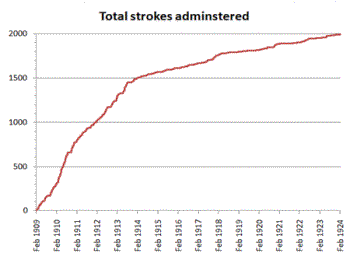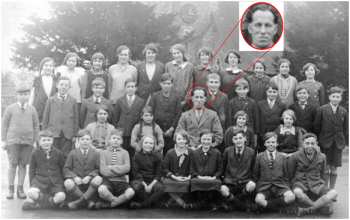
Hartlip School's Punishment Book
One of the documents that survives in Hartlip School is the School Punishment Book. It details all of the physical punishments administered on school children (almost exclusively boys) between 1909 and 1936.
In a paper entitled Corporal punishment in some English elementary schools, 1900-39, published in Research in Education in 1977, Musgrave states that,
"There is some evidence .... that much of the practice in the various school boards in relation to regulations concerning punishments was based on what had gradually evolved under the London School Board. At the first meeting of that board in 1871 regulations concerning punishments were passed. The first stated that 'every occurrence of corporal punishment shall be fully recorded in a book'."
However, he goes on to state that,
"... in mid-1908 some counties, e.g. Derbyshire, Devonshire, Kent, Lancashire, Leicestershire, Middlesex and Northumberland, had no regulations"

The book in Hartlip's records dates from 1909 so it seems likely that, in that year, the Kent Education Committee started to require schools to record instances of corporal punishment in a book.
The cover of Hartlip's book is shown on the right. It was a specially produced book, from the Educational Supply Association ('The Holborn Series of Registers') and was priced at 1s 6d.
Inside the Punishment Book, a copy of parts of a circular from The Kent Education Gazette has survived. Issued in 1920, the circular reminds teachers of a previous circular letter of 1910. This derived from the Suggestions for the Consideration of Teacher and Others, a publication of the Board of Education in 1905. It stated,
"The Committee have recently had before them the question of Corporal Punishment, and I am directed to say that they approve generally the principles laid down by the Board of Education in the Introduction to the Suggestions for the Consideration of Teachers and Others, but that the Committee consider that girls should not be subjected to corporal punishment unless in exceptional cases, and then only (1) at the hands of a woman teacher, (2) of such a kind as is approved by the Head Teacher, and (3) after school hours."
Mr. John Labrum
The first headmaster to feature in the Punishment Book is Mr John Labrum, who was headmaster from 1894 to 1924.
In the photo he appears a dapper gentleman but he was proficient with the cane. In the period covered by the Punishment Book during his term of office (2nd February 1909 to 12th of February 1924) he administered 2,002 blows of the cane. During this period there were 3,069 school days meaning that, on average, he caned at a rate of over half a blow per school day or one caning every two days.
Of the strokes administered 5 were on girls and 1,947 on boys. It is not known if the strokes on the girls were administered by a female teacher in line with the Code of the Board of Education.
Attitudes to punishment were very different in those days, and in an autobiography by Clifford Davison, he notes;
"If you did get into trouble then when you went to school you had to reckon with the Headmaster, who would give you a good caning and it hurt. It was very painful if the cane caught you across the thumb. On one occasion Fred Whitehead had his finger split open and his mother came to the school to see about it but she couldn't do anything. Bad behaviour had no sympathy ..."
It seems that, at some time around 1913 and 1914, Mr. Labrum relaxed his strict discipline regime. Breaking the data from the Punishment Book into two time periods gives the following results.
 |
 |
 |
| 1909 to Aug. 1914 | Sept. 1914 to 1924 | |
 |
||
| Number of strokes | 1,543 | 459 |
| Number of school days | 1,130 | 1,939 |
 |
||
| Strokes per day | 1.37 | 0.24 |
 |
||
The change in caning is quite marked and does not seem to have come about over a prolonged period. Rather, there was a sudden change. The graph on the right shows the total number of strokes administered. The graph rises steadily at the average rate of 1.37 a school day until around 1913/14, when there is a visible "flattening" as the "stroke rate" dropped. Examination of the School log look or Minute Book of the management meetings give no clue to this change in behaviour.

Mr. Southgate
Mr. Southgate took over the running of the school in 1924. He was far less likely to use the cane. Between March 1924 and April 1932 he administered just 71 strokes, or roughly 0.03 strokes a day, compared with Mr. Labrum’s overall average of 0.65.


